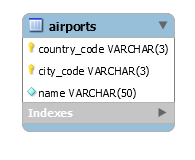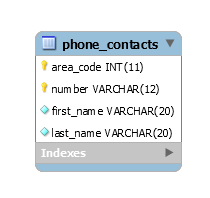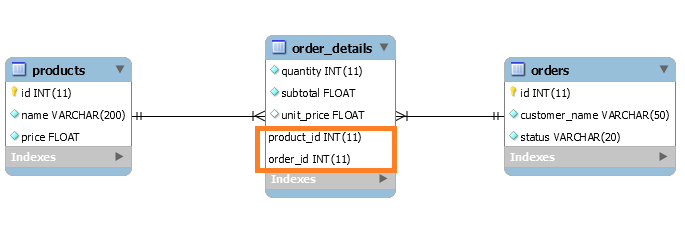Spring Data JPA Composite Primary Key Examples
- Details
- Written by Nam Ha Minh
- Last Updated on 21 November 2022 | Print Email
1. Spring Data JPA Composite Primary Key Example with @IdClass Annotation
Let’s see how to use the @IdClass annotation for mapping a composite primary key in Spring Data JPA. Suppose that we have the following table: This table has a composite primary key that consists of two columns country_code and city_code. So in Java code, create the following class that represents a composite ID field:
This table has a composite primary key that consists of two columns country_code and city_code. So in Java code, create the following class that represents a composite ID field:package net.codejava.airport;
import java.io.Serializable;
public class AirportID implements Serializable {
private String countryCode;
private String cityCode;
// getters and setters...
// equals and hashCode...
}This class is called ID class which must meet the following requirements:- The ID class must be public
- It must implement java.io.Serializable interface
- It must have no-argument constructor
- It must override equals() and hashCode()methods
And then code the entity class using JPA annotations as follows:package net.codejava.airport;
import javax.persistence.*;
@Entity
@Table(name = "airports")
@IdClass(AirportID.class)
public class Airport {
@Id @Column(length = 3)
private String countryCode;
@Id @Column(length = 3)
private String cityCode;
@Column(length = 50, nullable = false)
private String name;
// getters and setters...
// equals and hash Code
}You see, we use the @IdClass annotation to specify the name of the ID class that maps to the composite primary key in database. And in this approach, the entity class must redefine the fields in the ID class.package net.codejava.airport;
import org.springframework.data.repository.CrudRepository;
public interface AirportRepository extends CrudRepository<Airport, AirportID> {
}And below is a unit test class that demonstrates how to persist, list and query Airport objects:package net.codejava.airport;
import static org.assertj.core.api.Assertions.assertThat;
import java.util.Optional;
import org.junit.jupiter.api.Test;
import org.springframework.beans.factory.annotation.Autowired;
import org.springframework.boot.test.autoconfigure.jdbc.AutoConfigureTestDatabase;
import org.springframework.boot.test.autoconfigure.jdbc.AutoConfigureTestDatabase.Replace;
import org.springframework.boot.test.autoconfigure.orm.jpa.DataJpaTest;
import org.springframework.test.annotation.Rollback;
@DataJpaTest
@AutoConfigureTestDatabase(replace = Replace.NONE)
@Rollback(false)
public class AirportRepositoryTests {
@Autowired private AirportRepository repo;
@Test
public void testSaveNew() {
Airport airport = new Airport();
airport.setCountryCode("VN");
airport.setCityCode("HAN");
airport.setName("Noi Bai International Airport");
Airport savedAirport = repo.save(airport);
assertThat(savedAirport).isNotNull();
assertThat(savedAirport.getCountryCode()).isEqualTo("VN");
assertThat(savedAirport.getCityCode()).isEqualTo("HAN");
}
@Test
public void testListAll() {
Iterable<Airport> airports = repo.findAll();
assertThat(airports).isNotEmpty();
airports.forEach(System.out::println);
}
@Test
public void testFindById() {
AirportID id = new AirportID();
id.setCityCode("HAN");
id.setCountryCode("VN");
Optional<Airport> result = repo.findById(id);
assertThat(result).isPresent();
}
}As you can see, using @IdClass approach we have to redefine the fields that makeup composite ID in the entity class, which is somewhat inconvenient.
2. Spring Data JPA Composite Primary Key Example with @EmbeddedId Annotation
Next, let’s see another way of mapping composite primary key using @Embeddable and @EmbeddedId annotations. Given the following table that has a composite primary key area_code and number: So in Java code, you need to code the ID class as follows:
So in Java code, you need to code the ID class as follows:package net.codejava.phone;
import java.io.Serializable;
import javax.persistence.Column;
import javax.persistence.Embeddable;
@Embeddable
public class PhoneID implements Serializable {
@Column(name = "area_code")
private int areaCode;
@Column(length = 12)
private String number;
public PhoneID() {
}
public PhoneID(int areaCode, String number) {
this.areaCode = areaCode;
this.number = number;
}
// getters and setters...
// equals() and hashCode()...
}See the @Embeddable annotation used? And you can also use mapping annotations like @Column in the ID class. And code the entity class as follows:package net.codejava.phone;
import javax.persistence.*;
@Entity
@Table(name = "phone_contacts")
public class PhoneContact {
@EmbeddedId
private PhoneID id;
@Column(name = "first_name", nullable = false, length = 20)
private String firstName;
@Column(name = "last_name", nullable = false, length = 20)
private String lastName;
public PhoneID getId() {
return id;
}
// getters and setters...
// equals() and hashCode()...
}You see the @EmbeddedId annotation is used for the composite ID field? And code the repository interface as below:package net.codejava.phone;
import org.springframework.data.jpa.repository.JpaRepository;
public interface PhoneContactRepository extends JpaRepository<PhoneContact, PhoneID> {
}And below is an example unit test class:package net.codejava.phone;
import static org.assertj.core.api.Assertions.assertThat;
import java.util.List;
import java.util.Optional;
import org.junit.jupiter.api.Test;
import org.springframework.beans.factory.annotation.Autowired;
import org.springframework.boot.test.autoconfigure.jdbc.AutoConfigureTestDatabase;
import org.springframework.boot.test.autoconfigure.jdbc.AutoConfigureTestDatabase.Replace;
import org.springframework.boot.test.autoconfigure.orm.jpa.DataJpaTest;
import org.springframework.test.annotation.Rollback;
@DataJpaTest
@AutoConfigureTestDatabase(replace = Replace.NONE)
@Rollback(false)
public class PhoneContactRepositoryTests {
@Autowired private PhoneContactRepository repo;
@Test
public void testSaveNew() {
PhoneID id = new PhoneID(1, "12027933129");
PhoneContact newContact = new PhoneContact();
newContact.setId(id);
newContact.setFirstName("John");
newContact.setLastName("Kellyson");
PhoneContact savedContact = repo.save(newContact);
assertThat(savedContact).isNotNull();
assertThat(savedContact.getId().getAreaCode()).isEqualTo(1);
assertThat(savedContact.getId().getNumber()).isEqualTo("12027933129");
}
@Test
public void testListAll() {
List<PhoneContact> contacts = repo.findAll();
assertThat(contacts).isNotEmpty();
contacts.forEach(System.out::println);
}
@Test
public void testFindById() {
PhoneID id = new PhoneID(1, "12027933129");
Optional<PhoneContact> result = repo.findById(id);
assertThat(result).isPresent();
}
}You see, this class tests for save, list and query against entity objects that have composite ID field. And in this approach, the ID class and entity class do not have duplicate fields.
3. Spring Data JPA Composite Primary Key Example with Foreign Key Reference
And how about mapping a composite primary key that consists of foreign keys? Let’s see the code example below. Given the following 3 tables that form a many-to-many relationship: Here, the order_details table realizes many to many association between products and orders tables. It has the composite primary key that consists of two foreign keys. So in Java code, we have the Product entity class as below:
Here, the order_details table realizes many to many association between products and orders tables. It has the composite primary key that consists of two foreign keys. So in Java code, we have the Product entity class as below:package net.codejava.sale;
import javax.persistence.*;
@Entity
@Table(name = "products")
public class Product {
@Id
@GeneratedValue(strategy = GenerationType.IDENTITY)
private Integer id;
@Column(nullable = false, length = 200)
private String name;
private float price;
// getters and setters
// equals() and hashCode()
}Code of the Order entity class:package net.codejava.sale;
import javax.persistence.*;
@Entity
@Table(name = "orders")
public class Order {
@Id
@GeneratedValue(strategy = GenerationType.IDENTITY)
private Integer id;
@Column(name = "customer_name", length = 50, nullable = false)
private String customerName;
@Column(length = 20, nullable = false)
private String status;
}And code of the ID class that maps to the composite primary key in the database table:package net.codejava.sale;
import java.io.Serializable;
import javax.persistence.*;
@Embeddable
public class OrderDetailID implements Serializable {
@ManyToOne
@JoinColumn(name = "order_id")
private Order order;
@ManyToOne
@JoinColumn(name = "product_id")
private Product product;
// getters and setters...
// equals() and hashCode()...
}As you can see, for foreign key mapping we use the @ManyToOne and @JoinColumn annotations as usual in the ID class. And below is code of the entity class that makes use of this composite ID:package net.codejava.sale;
import javax.persistence.*;
@Entity
@Table(name = "order_details")
public class OrderDetail {
@EmbeddedId
private OrderDetailID id;
private int quantity;
@Column(name = "unit_price")
private float unitPrice;
private float subtotal;
// getters and setters...
// equals() and hashCode()...
}For Spring Data JPA, code the repository interface as follows:package net.codejava.sale;
import org.springframework.data.jpa.repository.JpaRepository;
public interface OrderDetailRepository extends JpaRepository<OrderDetail, OrderDetailID> {
}And for your reference, below is code example of a unit test class that demonstrates how to persist and list objects:package net.codejava.sale;
import static org.assertj.core.api.Assertions.assertThat;
import java.util.List;
import org.junit.jupiter.api.Test;
import org.springframework.beans.factory.annotation.Autowired;
import org.springframework.boot.test.autoconfigure.jdbc.AutoConfigureTestDatabase;
import org.springframework.boot.test.autoconfigure.jdbc.AutoConfigureTestDatabase.Replace;
import org.springframework.boot.test.autoconfigure.orm.jpa.DataJpaTest;
import org.springframework.test.annotation.Rollback;
@DataJpaTest
@AutoConfigureTestDatabase(replace = Replace.NONE)
@Rollback(false)
public class OrderDetailRepositoryTests {
@Autowired private OrderDetailRepository orderDetailRepo;
@Autowired private ProductRepository productRepo;
@Autowired private OrderRepository orderRepo;
@Test
public void testListAll() {
List<OrderDetail> orderDetails = orderDetailRepo.findAll();
assertThat(orderDetails).isNotEmpty();
orderDetails.forEach(System.out::println);
}
@Test
public void testAddOrderDetail() {
Product product = new Product();
product.setName("iPhone 15");
product.setPrice(1199);
productRepo.save(product);
Order order = new Order();
order.setCustomerName("Nam Ha Minh");
order.setStatus("In Progress");
orderRepo.save(order);
OrderDetail orderDetail = new OrderDetail();
OrderDetailID orderDetailId = new OrderDetailID();
orderDetailId.setOrder(order);
orderDetailId.setProduct(product);
orderDetail.setId(orderDetailId);
orderDetail.setQuantity(2);
orderDetail.setUnitPrice(1199);
orderDetail.setSubtotal(2398);
OrderDetail savedOrderDetail = orderDetailRepo.save(orderDetail);
assertThat(savedOrderDetail).isNotNull();
assertThat(savedOrderDetail.getId().getProduct()).isEqualTo(product);
assertThat(savedOrderDetail.getId().getOrder()).isEqualTo(order);
}
}That’s my guide about mapping composite primary key in Spring Data JPA. I hope you found the code examples helpful. To see the coding in action, watch the following video: Related Spring and Database Tutorials:
- Spring Data JPA EntityManager Examples (CRUD Operations)
- JPA EntityManager: Understand Differences between Persist and Merge
- Understand Spring Data JPA with Simple Example
- Spring Data JPA Custom Repository Example
- Spring MVC with JdbcTemplate Example
- How to configure Spring MVC JdbcTemplate with JNDI Data Source in Tomcat
- Spring and Hibernate Integration Tutorial (XML Configuration)
- Spring MVC + Spring Data JPA + Hibernate - CRUD Example
About the Author:
 Nam Ha Minh is certified Java programmer (SCJP and SCWCD). He began programming with Java back in the days of Java 1.4 and has been passionate about it ever since. You can connect with him on Facebook and watch his Java videos on YouTube.
Nam Ha Minh is certified Java programmer (SCJP and SCWCD). He began programming with Java back in the days of Java 1.4 and has been passionate about it ever since. You can connect with him on Facebook and watch his Java videos on YouTube.
Comments